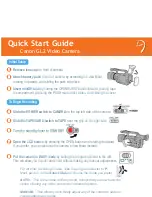
Others
61
ª
Playing Back on Your TV
≥
Depending on your TV, nothing may be shown
even if you correctly connect the Movie Camera
with your TV. In this case, set [AV JACK] on the
[AV IN/OUT] or [INITIAL] Sub-Menu to [OUT].
≥
If you set [AV JACK] on the [AV IN/OUT]
Sub-Menu to [IN/OUT], nothing will be shown
on the TV screen except during playback.
≥
Picture size may be displayed differently when
playing back a Cinema picture on a wide-screen
TV with Playback Digital Effect.
ª
Audio Dubbing
≥
The blank section of a tape cannot be dubbed.
≥
Sounds sent through the DV Terminal cannot
be dubbed.
≥
If a tape has a non-recorded portion when the
tape is dubbed, images and sounds may be
disturbed when this portion of the tape is played
back.
≥
If you set the tape counter back to 0 at the
position where you want to stop Audio Dubbing
so as to make it possible to use the Memory
Stop Function (
-68-
), Audio Dubbing is
terminated automatically when the tape reaches
this position.
≥
In the case of importing data recorded with
Audio Dubbing to a PC using the PC’s software,
only the original sound (ST1) may be imported,
depending on the software.
ª
Recording the Contents of Other
Equipment
≥
You cannot record on a card when recording on
a tape from external input signals is in progress.
Recording to a Card
If you set the Mode Dial to Card Recording Mode,
you can use the Photoshot function for external
input signals.
≥
Black streaks may appear at the 4 edges of the
image.
Analog-Digital Conversion
≥
When the Movie Camera is connected with
other digital video equipment through its DV
Terminal, images recorded in analog form from
other external equipment can be output to the
digital video equipment through the DV
Terminal.
≥
To DV-output analog video signals sent from
other equipment, set [DV OUT] on the
[AV IN/OUT] Sub-Menu to [ON]. (Normally,
keep the [DV OUT] set to [OFF]. If it is set to
[ON], the quality of the image may be
disturbed.)
≥
When using AV Cable and DV Cable (optional)
at the same time, detach the Grip Belt first for
easy connecting.
ª
Using the DV Cable for Recording
(Digital Dubbing)
≥
Regardless of the setting, digital dubbing is
carried out automatically in the same audio
recording mode as that of the playback
Cassette.
≥
The images on the recorded monitor may be
disturbed, but it does not affect the recorded
images.
≥
Even if Playback Digital Effects, Playback
Zoom, or Playback Title In have been used,
these effects are not output from the DV
Terminal.
≥
Even if you use device equipped with DV
Terminals (such as IEEE1394), you may not be
able to perform Digital Dubbing in some cases.
≥
Date or other information to be displayed cannot
be displayed if the software of the connected
equipment does not support the display
function.
≥
You cannot record on a card when recording on
a tape from external input signals is in progress.
≥
Disconnect the USB Cable since input signals
from external input terminal cannot be recorded
with connecting the USB Cable.
Cautions for Use
In the event of abnormal operation (e.g. if the unit
emits smoke or an unusual smell), immediately
stop operating the unit and consult the Panasonic
Customer Care Centre on 132600.
ª
After Use
1
Take out the Cassette. (
-11-
)
2
Set the [OFF/ON] Switch to [OFF].
3
Take out the Card. (
-11-
)
4
Detach the power supply and retract the
Viewfinder or the LCD Monitor. (
-8-
,
-12-
)
5
To protect the Lens, attach the supplied
Lens Cap.
ª
Cautions for Use
When you use your Movie Camera on a rainy
or snowy day or on a beach, make sure that
no water enters the Movie Camera.
≥
Water may cause the Movie Camera or
Cassette to malfunction. (Irreparable failure
may occur.)
≥
If sea water splashes onto the Movie Camera,
wet a soft cloth with tap water, wring it well, and
use it to wipe the camera body carefully. Then,
wipe it again thoroughly with a soft dry cloth.
400GN.book 61 ページ 2004年6月3日 木曜日 午後1時49分












































